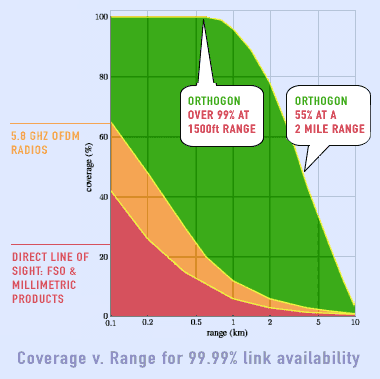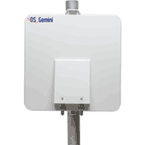Morotorla (formerly Orthogon Systems)
In Non-Line-of-Sight (NLoS) environments, signals arrive via many different (dispersed) paths. The path lengths vary, so the signals also arrive at different times. In addition, the paths have different delay characteristics, causing previously transmitted data bits to interfere with current data bits. This interference is known as multipath inter-symbol-interference or ISI. Conventional radios resolve the problem using an ISI equalizer. Many NLoS vendors employ some form of OFDM (Orthogonal Frequency Division Multiplexing) to overcome this problem, but none of them add the intelligence that is embedded in Motorola's intelligent OFDM ( i -OFDM).
 OS-Gemini & Gemini Lite OS-Gemini & Gemini Lite
- Connectorized or integrated antenna versions
- 22 and 44 Mbps maximum bandwidth solutions
- 5.7 GHz operational frequency
OS-Spectra & Spectra Lite
- Connectorized or integrated antenna versions
- 300 Mbps maximum bandwidth solutions
- 5.7 GHz operational frequency
Motorola is the only manufacturer that includes spatial diversity in its radios to combat ducting and multipath fading, allowing communications to travel over water, across vast expanses of open terrain and in deep non-line-of-sight environments without signal loss.
As radio waves travel across distances, especially over water and flat terrain, they run an increased risk of multipath interference caused by signals reflecting off the water, desert or flat plain. This interference can cause the signals to cancel each other as they travel to the receiver from various directions over multiple paths. In addition, signals can experience ducting as they move through air masses of different densities, which deflect the signals away from the receiving antenna, often cutting communication between radios.
Motorola's i -OFDM separates data into channels, which overlap in frequency. That is, the channels are orthogonal to each other, so they do not interfere with each other, resulting in better spectrum efficiency and higher data throughput. In addition, i -OFDM allows the radio to compensate for environmental conditions by applying a uniform phase correction to all channels simultaneously - a correction value that can be modified on the fly in response to external events. Thus, Motorola's i -OFDM not only resolves channel dispersion, achieves high spectral efficiency and offers high resistance to frequency-selective fading,  With Adaptive Modulation, the radio power output is dynamically modified according to the received signal level, upshifting or downshifting to overcome fading. Since the channel may vary in intensity on a sub-second basis, adapting the modulation dynamically allows the maximum amount of data possible to be sent across the path while keeping the link quality at the highest level. With Adaptive Modulation, the radio power output is dynamically modified according to the received signal level, upshifting or downshifting to overcome fading. Since the channel may vary in intensity on a sub-second basis, adapting the modulation dynamically allows the maximum amount of data possible to be sent across the path while keeping the link quality at the highest level.
|

